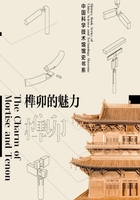
第二章 古代建筑的智慧 Chapter Two The Wisdom of Ancient Architecture
以木构架为主要结构方式的中国古代建筑,风格独特、自成体系,在世界建筑史上独树一帜,是人类建筑宝库中的一颗明珠。中国的木构架一般包括柱、梁、枋、檩、斗拱、椽子等基本构件,这些构件相互独立,需要用榫卯结构连接起来才能组成建筑。因此,榫卯结构是中国古代木构建筑系统的基本特征,也是中国建筑中最早具有科学意义的设计语言。中国古代出现过很多历经几百年不倒的建筑传奇,这些木构古建筑经受了多次地震的考验仍能安然无恙、巍然挺立,很大程度上归功于榫卯结构的巧妙设计。
Ancient Chinese architecture with wooden framework as its main structure has a unique style and self-contained system, which is distinguished in the history of world architecture as a pearl in the treasure house of human architecture. Chinese wooden framework generally includes basic components such as pillars, beams, tie beams, purlins, dougong and rafters, which are independent to each other and need to be connected in the structure of mortise and tenon to construct a building. Therefore, the mortise and tenon structure is the basic feature of the ancient Chinese wooden architectural system and also the earliest scientifically significant architectural language in China. In ancient China, there have been many legends of buildings that have not fallen for hundreds of years. The buildings have withstood many earthquakes and are still intact, which is largely attributed to the intelligent design of the mortise and tenon structure.